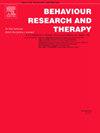网络干预分析一种预防慢性背痛患者抑郁的数字化干预方法
IF 4.5
2区 心理学
Q1 PSYCHOLOGY, CLINICAL
引用次数: 0
摘要
抑郁症经常与慢性背痛(CBP)共同发生,使治疗结果复杂化,并增加了医疗保健利用率。数字干预已证明对CBP患者预防重度抑郁症(MDD)有效。然而,人们对这些干预措施如何在症状水平上发挥作用知之甚少。这是一项针对亚临床抑郁症和合并CBP患者预防抑郁症的随机对照试验的二级分析。N = 295名参与者被随机分为持续约8周的数字干预组或常规治疗对照组(TAU)组。采用网络分析方法对多病症状网络结构和干预的症状特异性治疗效果进行检验。采用9项患者健康问卷(PHQ-9)评估抑郁症状,采用10项Oswestry残疾指数(ODI)测量疼痛相关残疾。干预前症状网络的网络分析表明,抑郁症状“能量”是连接抑郁和疼痛残疾症状社区的最强桥梁。干预后治疗对“能量”症状的影响最大(PHQ4, -0.18)。此外,干预直接改善了“注意力”(PHQ7, -0.13)和“疼痛强度”(ODI1, -0.09)。目前的研究强调了“能量”症状在多病性抑郁症和CBP中可能起的作用。它还提供了一种假设的机制,通过干预预防CBP患者的重度抑郁症发挥其作用。使用网络分析的症状级方法可能有助于更深入地了解多病,并为制定更有针对性、更有效的干预措施提供框架。本文章由计算机程序翻译,如有差异,请以英文原文为准。
Network intervention analysis of a digital intervention for the prevention of depression in patients with chronic back pain
Depression frequently co-occurs with chronic back pain (CBP), complicating treatment outcomes and increasing healthcare utilization. Digital interventions have demonstrated efficacy for the prevention of major depressive disorder (MDD) in individuals with CBP. However, little is known about how these interventions exert the effects at the symptom level. This was a secondary analysis of a RCT for the prevention of depression in patients with subclinical symptoms of depression and co-occurring CBP. N = 295 participants were randomized to a digital intervention lasting approximately 8 weeks or a treatment-as-usual control (TAU) group. Network analysis was used to examine the multimorbid symptom network structure and the symptom-specific treatment effects of the intervention. Depressive symptoms were assessed by the 9-item patient health questionnaire (PHQ-9) and pain-related disability was measured by the 10-item Oswestry Disability Index (ODI). Network analysis of the symptom networks prior to the intervention revealed that the depressive symptom “energy” was the strongest bridge connecting the communities of depression and pain disability symptoms. The largest influence of the intervention post-treatment was also on the “energy” symptom (PHQ4, -0.18). Additionally, the intervention directly improved “concentration” (PHQ7, -0.13), and “pain intensity” (ODI1, -0.09). The current study highlights the role that the symptom of “energy” may play in multimorbid depression and CBP. It also provides a hypothetical mechanism by which in intervention for the prevention of MDD in patients with CBP exerted its effects. Symptom-level approaches using network analysis may facilitate a deeper understanding of multimorbidity, as well as a framework for developing more targeted, effective interventions.
求助全文
通过发布文献求助,成功后即可免费获取论文全文。
去求助
来源期刊

Behaviour Research and Therapy
PSYCHOLOGY, CLINICAL-
CiteScore
7.50
自引率
7.30%
发文量
148
期刊介绍:
The major focus of Behaviour Research and Therapy is an experimental psychopathology approach to understanding emotional and behavioral disorders and their prevention and treatment, using cognitive, behavioral, and psychophysiological (including neural) methods and models. This includes laboratory-based experimental studies with healthy, at risk and subclinical individuals that inform clinical application as well as studies with clinically severe samples. The following types of submissions are encouraged: theoretical reviews of mechanisms that contribute to psychopathology and that offer new treatment targets; tests of novel, mechanistically focused psychological interventions, especially ones that include theory-driven or experimentally-derived predictors, moderators and mediators; and innovations in dissemination and implementation of evidence-based practices into clinical practice in psychology and associated fields, especially those that target underlying mechanisms or focus on novel approaches to treatment delivery. In addition to traditional psychological disorders, the scope of the journal includes behavioural medicine (e.g., chronic pain). The journal will not consider manuscripts dealing primarily with measurement, psychometric analyses, and personality assessment.
 求助内容:
求助内容: 应助结果提醒方式:
应助结果提醒方式:


